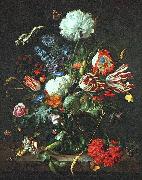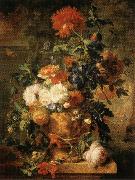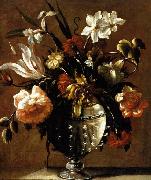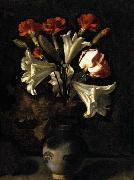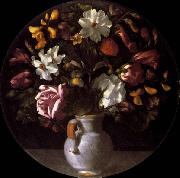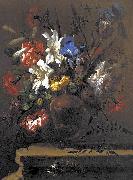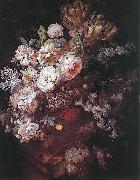Wholesale Oil Painting Reproductions No Minimum and Door to Door! |
|||||||||||
|
|
|||||||||||

|
|||||||||||
|
|
|
||||||||
All Carlo Dolci Oil Paintings |
||||||||
|
|
||||||||
|
|
||||||||
|
Artist Introduction: 1616-1686
Italian
Carlo Dolci Locations
Italian painter. The major Florentine painter of the 17th century, he enjoyed an international reputation in his own lifetime. He was a gifted portrait painter and painted a number of large altarpieces, but his reputation is largely based on his half-length, single-figure paintings, characterized by their intense religiosity and meticulous technique. His mature style was complex and sophisticated. Intended for cultivated and aristocratic circles, his was never a popular art in any sense. Baldinucci described the painter tormented fantasy and dark fantasms, and his disturbed personality is evident throughout his work after the later 1640s. |
||||||||
|
|
||||||||
|
Vase of Flowers Painting ID:: 979 |
1665-75
Galleria degli Uffizi, Florence |
|||||||
Height Width |
INS/CM Quality |
|||||||
|
X |
| |||||||
|
|
||||||||
All Jan Davidsz. de Heem Oil Paintings |
||||||||
|
|
||||||||
|
|
||||||||
|
Artist Introduction: stilllife masters, Dutch Baroque Era Painter, 1606-C.1683 |
||||||||
|
|
||||||||
|
|
Vase of Flowers Painting ID:: 10196 |
1645Oil on canvas
69,6 x 56,5 cm
National Gallery
of Art, Washington |
||||||
Height Width |
INS/CM Quality |
|||||||
|
X |
| |||||||
|
|
||||||||
All Jan Davidsz. de Heem Oil Paintings |
||||||||
|
|
||||||||
|
|
||||||||
|
Artist Introduction: stilllife masters, Dutch Baroque Era Painter, 1606-C.1683 |
||||||||
|
|
||||||||
|
|
Vase of Flowers Painting ID:: 10203 |
Oil on canvas,
87,5 x 67,5 cm
The Hermitage,
St. Petersburg |
||||||
Height Width |
INS/CM Quality |
|||||||
|
X |
| |||||||
|
|
||||||||
All HUYSUM, Jan van Oil Paintings |
||||||||
|
|
||||||||
|
|
||||||||
|
Artist Introduction: Dutch Painter, 1682-1749
Dutch painter of still life and landscapes. His father was Justus van Huysum (1659?C1716), a successful landscape and genre painter of Amsterdam. Although he painted landscapes in a classical style, Jan is best known for his flower and fruit still lifes in oil and in watercolor. These are distinguished for their brilliant light and shade effects, delicacy of coloring, and exquisite finish. They are to be found in most of the leading European museums |
||||||||
|
|
||||||||
|
|
Vase of Flowers Painting ID:: 30926 |
mk68
1722
|
||||||
Height Width |
INS/CM Quality |
|||||||
|
X |
| |||||||
|
|
||||||||
All unknow artist Oil Paintings |
||||||||
|
|
||||||||
|
|
||||||||
|
Artist Introduction: |
||||||||
|
|
||||||||
|
|
Vase of Flowers Painting ID:: 52613 |
c. 1650 Oil on canvas, 47 x 40 cm |
||||||
Height Width |
INS/CM Quality |
|||||||
|
X |
| |||||||
|
|
||||||||
All Juan de Flandes Oil Paintings |
||||||||
|
|
||||||||
|
|
||||||||
|
Artist Introduction: Flemish-born Spanish Northern Renaissance Painter, ca.1460-1519
South Netherlandish painter, active in Spain. Nothing is known of his life or work before he went to Spain, where he is first mentioned in a document of 1496 as Juan de Flandes, a painter in the service of Queen Isabella of Castile. Treasury accounts confirm that he held this position until the Queen death in 1504. On arriving in Spain, he must have lived in Burgos, where he certainly met MICHEL SITTOW, another painter in the Queen service, who had been at the Castilian court since 1492. |
||||||||
|
|
||||||||
|
|
Vase of Flowers Painting ID:: 52640 |
1635-36 Oil on canvas, 44 x 34 cm |
||||||
Height Width |
INS/CM Quality |
|||||||
|
X |
| |||||||
|
|
||||||||
All Juan de Flandes Oil Paintings |
||||||||
|
|
||||||||
|
|
||||||||
|
Artist Introduction: Flemish-born Spanish Northern Renaissance Painter, ca.1460-1519
South Netherlandish painter, active in Spain. Nothing is known of his life or work before he went to Spain, where he is first mentioned in a document of 1496 as Juan de Flandes, a painter in the service of Queen Isabella of Castile. Treasury accounts confirm that he held this position until the Queen death in 1504. On arriving in Spain, he must have lived in Burgos, where he certainly met MICHEL SITTOW, another painter in the Queen service, who had been at the Castilian court since 1492. |
||||||||
|
|
||||||||
|
|
Vase of Flowers Painting ID:: 52641 |
Vase of Flowers 1636 Oil on canvas |
||||||
Height Width |
INS/CM Quality |
|||||||
|
X |
| |||||||
|
|
||||||||
All Bartolome Perez Oil Paintings |
||||||||
|
|
||||||||
|
|
||||||||
|
Artist Introduction: (1634-1693) was a Spanish painter of the Baroque period.
Born in Madrid, he became the son-in-law and pupil of the painter Juan de Arellano. Known as a painter of flowers and still life, known as bodegones. He also painted scenography for performances at the theater of Buen Retiro, for which he was named painter of the King without salary in January of 1689. He died after falling from a scaffold used to paint the ceiling of the palace of Monteleon, and was buried in the church of San Ildefonso.
|
||||||||
|
|
||||||||
|
|
Vase of Flowers Painting ID:: 76088 |
. 1690
Medium Oil on panel
Dimensions 55 ?? 42 cm (21.7 ?? 16.5 in)
cyf |
||||||
Height Width |
INS/CM Quality |
|||||||
|
X |
| |||||||
|
|
||||||||
All Jan van Huijsum Oil Paintings |
||||||||
|
|
||||||||
|
|
||||||||
|
Artist Introduction: also spelled Huijsum, (April 15, 1682, Amsterdam - February 8, 1749, Amsterdam) was a Dutch painter.
He was the brother of Jacob van Huysum, the son of the flower painter Justus van Huysum, and the grandson of Jan van Huysum I, who is said to have been expeditious in decorating doorways, screens and vases. A picture by Justus is preserved in the gallery of Brunswick, representing "Orpheus and the Beasts in a wooded landscape", and here we have some explanation of his son's fondness for landscapes of a conventional and Arcadian kind; for Jan van Huysum, though skilled as a painter of still life, believed himself to possess the genius of a landscape painter.
Half his pictures in public galleries are landscapes, views of imaginary lakes and harbours with impossible ruins and classic edifices, and woods of tall and motionless trees-the whole very glossy and smooth, and entirely lifeless. The earliest dated work of this kind is that of 1717, in the Louvre, a grove with maidens culling flowers near a tomb, ruins of a portico, and a distant palace on the shores of a lake bounded by mountains.
Some of the finest of van Huysum's fruit and flower pieces have been in English private collections: those of 1723 in the earl of Ellesmere's gallery, others of 1730-1732 in the collections of Hope and Ashburton. One of the best examples is now in the National Gallery, London (1736-1737). No public museum has finer and more numerous specimens than the Louvre, which boasts of four landscapes and six panels with still life; then come Berlin and Amsterdam with four fruit and flower pieces; then St Petersburg, Munich, Hanover, Dresden, the Hague, Brunswick, Vienna, Carlsruhe, Boston and Copenhagen. |
||||||||
|
|
||||||||
|
|
Vase of Flowers Painting ID:: 89129 |
first half of 18th century
Medium oil on glass
cyf |
||||||
Height Width |
INS/CM Quality |
|||||||
|
X |
| |||||||
|
|
||||||||
|
Prev Next
|
||||||||
|
|
||||||||
|
Related Paintings to Jan van Huijsum :. |
||||||||
|
|
||||||||
|
CONTACT US |


